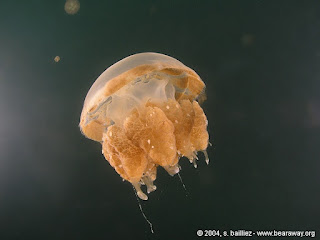The island is like the figure “9”, with an atoll or ring-shaped coral in the north and a lagoon inside the circle, which nearby people call Lake Kakaban.
Lake Kakaban contains brackish water with marine biota already undergoing evolution while being trapped inside, producing species different in nature and physical features from those found in the sea. Among them is transparent-body jellyfish (Aurelia aurita), and another lovelier jellyfish the size of the index finger (Tripedalia cystophora).
 The one as big as a fist, like a brownish blue incandescent lamp (Martigias papua), is more dominant in number. Along with the three jellyfish species is Cassiopeia ornata, which has become the trademark of Kakaban Island.
The one as big as a fist, like a brownish blue incandescent lamp (Martigias papua), is more dominant in number. Along with the three jellyfish species is Cassiopeia ornata, which has become the trademark of Kakaban Island.What distinguishes these endemic species from those in the open sea is the loss of their stinging capacity. Of the four, Kakaban’s prized Cassiopeia has a unique habit of swimming upside down, with its tentacles facing upward.
There are eight fish species in Lake Kakaban, four notable ones are serinding (Apogon lateralis), puntang (Exyrias puntang), coral fry (Antherinomorus endrachtensis) and needle fish (Zenarchopterus dispar). Rhizopoda roots on the bank of the lake are also found to bear Halimeda and Caulepa algae, resembling small green grapes. Kakaban is thus virtually the last bastion of marine biota in the zone protected from invasion by an ever growing population.
Arif Hadianto, an underwater photographer from Berau Coal Diving Club, mentioned several points on Kakaban Island called Barracuda Point, The Drift, Cabbage Patch, The Wall, Blue Light Cave, The Plateau, Rainbow Run, Diver’s Delight and The North Face.
“The names indicate the different underwater panoramas of various types of diving locations on the island. The animals in this lake produce more colorful lights when it’s getting darker,” he said.
Endemic species: Kakaban Island is home to a few endemic species of jellyfish. Courtesy of Arif Hadianto/Berau Coal Diving ClubResearch conducted by The Nature Conservancy (TNC) in 2004 showed such islands as Maratua, Derawan, Sangalaki and Kakaban were at least home to 444 species of hard coral, 872 species of endemic fish and stingless jellyfish, in the waters of Berau regency. Besides, the largest green turtles in Southeast Asia also lay eggs on the islands.
Kakaban, itself covering 774.2 hectares, belongs to the island group of Derawan. Unlike Derawan with a population of over 4,000 and Maratua with 3,000 Bajo people, Kakaban is uninhabited. Europeans dub the Bajo ethnics sea gypsies or sea nomads. Kakaban in the Bajo tongue means embracing.
 |
| dive with jellyfish |
It takes 45 minutes from Derawan to Kakaban by speedboat with a capacity of 15 people, costing three times as much as sailing by fishing boat with 4 passengers, which can be hired at only Rp 400,000 for the same distance.
Apart from developing marine tourism on Maratua and Derawan Islands, the Berau regency administration, East Kalimantan, supported by Berau Coal, a coal mining company, is also boosting tourism on Kakaban Island.
Two speedboats sailed rapidly, leaving Maratua Island where The Amazing Derawan Archipelago Underwater Photo Contest was held with photographers from Japan, Australia and other countries participating on March 5-9.
East Kalimantan Deputy Governor Farid Wadjdy and several staff members were apparently stunned by two dolphins leaping around, as if trying to compete with the speedboat.
“After watching underwater photos presenting beautiful submarine panoramas, the view observed from aboard the speedboat is also thrilling with the two dolphins going along,” he pointed out.
East Kalimantan, according to Farid, is not only the second largest province in Indonesia with an area of 245,000 square kilometers or about 11 percent of the country’s territory, but also has marine potential as its major asset.
 |
| Map of Kakaban |
Before reaching the jellyfish lake, Farid and his team had to walk up steps and go down a bank stretching along 120 meters, with the sounds of birds coming from thickets of mangroves on both sides, of the species of tanjang (Bruguiera), apiapi (Avicennia), and pidada (Sonneratia).
Empty island: Several tourists sit in a resort on nearby Maratua Island, the nearest island to Kakaban Island. JP/Indra HarsaputraBerau Regent Makmur expected the provincial administration and central government to build an airport on Maratua Island. With the airport, he hoped the transportation of tourists from Balikpapan to Maratua would be expedited.
Berau Coal spokesman Bintoro Prabowo said Kakaban as an asset of the Berau administration should have its ecosystem conserved. The company has undertaken some activities such as supporting the World Wildlife Fund (WWF) program for the conservation of coral reefs as well as the protection of green turtles (Chelonia mydas) and hawksbill turtles (Eretmochelys imbricata).
A marine expert from Canada, Thomas Tomascik, once called Kakaban a paradise of biological resources in Indonesia. Besides in Micronesia and Philippine islands, brackish water lagoons in the world can also be found on this island. Quote from Jakarta Post


No comments:
Post a Comment